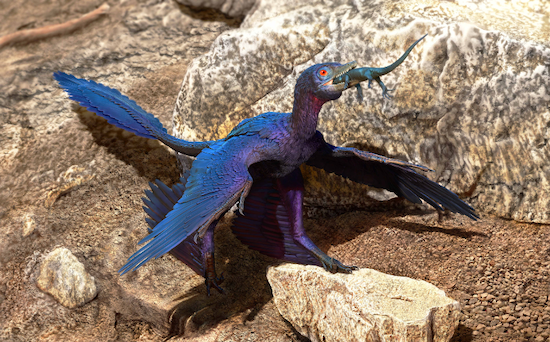 Evolution & Behaviour
Evolution & Behaviour
Microraptor and Indrasaurus: food for thought
Flying is hard. To achieve such an endeavor, bird digestion must be super-efficient, with many of them regurgitating pellets like owls. The flying dromaeosaur Microraptor lacked this ability. Stomach contents are rare in fossils, but this new Microraptor preserves a new species of lizard, Indrasaurus.

Fossils are rare - fossils with traces of food even more so. However, only these can tell us something about an extinct species' diet. Knowledge of predator-prey relationships is necessary to better understand ancient ecosystems, like the 131-120 million-year-old Jehol Biota in northeastern China. Through this knowledge, we not only know more about an individual species' biology, but we also know how different species interacted with each other. Characteristics of these ingested remains, such as location within the body and level of articulation, can also tell us about the design and function of the digestive system itself. The rocks preserving the Jehol Biota are unusually rich in fossils (and these fossils are remarkably well preserved). They revealed lots of animals but is most famous for preserving a whole diversity of feathered dinosaurs. Among those, Guan long, a feathered tyrannosaurid and Caudipteryx, the most primitive dinosaur with wings that wasn't flying. These also include the flying four-winged dinosaur Microraptor (it had wings on its hands AND feet).
Over 200 exceptional, nearly complete, specimens of Microraptor have been collected. This one, however, is only the fourth to preserve stomach contents: a new species of lizard (Indrasaurus wangi) with teeth unlike any other currently known. Other than that, we can't say what it was specialized to feed on. Without direct evidence in the form of stomach contents, any hypothesis based on tooth morphology is just a guess). Other specimens show that Microraptor also ate birds, mammals, and fish (meaning it was an opportunistic predator that ate what it could get). Still, food is only found in the stomach.
In contrast, the troodontid Anchiornis (an older but reasonably closely related dinosaur in which flight is a maybe... but probably not) preserves food only in the form of pellets (like those regurgitated by owls). One specimen preserves a pellet in the throat about to be regurgitated consisting of lizard bones, indicating that Anchiornis and Microraptor had similar diets. Still, they didn't compete with each other, Anchiornis being about 40 million years older. Three other specimens preserve pellets near the body, considered by previous researchers to have been regurgitated shortly before death. But since the pellets are outside the body and consist of fish bones, to be accurate, we cannot be absolutely sure that Anchiornis made these pellets.
The ability to form and egest pellets, suggests Anchiornis had a better digestive system than most other dinosaurs, which lacked this ability. Pellet egestion means that food can be digested faster and thus more efficiently. Many improvements in the dinosaurian digestive system evolved in the avian lineage (absent in other groups of dinosaurs). Among those, the forming of pellets is thought to be related to flight. They evolved to help meet the energetic demands of bird flight, which is the most physically demanding form of locomotion currently utilized by animals. But Microraptor could fly, and Anchiornis probably could not. Such a difference suggests that the ability to form pellets evolved independent of flight, at least in Anchiornis, and may even have evolved more than once. If Anchiornis is part of the group of dinosaurs most closely related to birds than maybe pellet formation evolved once. But currently, there is no evidence that the most primitive birds (like Archaeopteryx or Confuciusornis) had this ability. This fact may suggest that pellet formation evolved in dinosaurs twice - once in birds and once in the Anchiornis lineage. In contrast, Microraptor would have probably taken longer to digest each meal, and small bits of bone would be present in its feces, similar to what we know about T. rex.
The incredible preservation of the Jehol Biota has revealed 20 occurrences (and counting) of direct evidence of diet - essentially 20 links in the incredibly complex food web that existed 131-120 million years ago. Although very incomplete, this preliminary food web pointed out the importance of fish in supporting secondary consumers (predatorial animals) in this ecosystem.
Original Article:
O'Connor J, Zheng X, Dong L et al. Microraptor with Ingested Lizard Suggests Non-specialized Digestive Function. Current Biology. 2019;29(14):2423-2429.e2.Edited by:
Massimo Caine , Founder and Director
We thought you might like
The clock as a frenemy: the importance of the biological rhythms in cancer prognosis
Jun 1, 2021 in Health & Physiology | 3.5 min read by Ignacio Aiello , Natalia PaladinoTurning on the lights: how long did it take for the Sun to form?
Sep 30, 2021 in Earth & Space | 3.5 min read by Gregory A. BrenneckaNitrogen pollution from lowlands reaches distant mountain lakes
Sep 21, 2016 in Earth & Space | 3 min read by Beth Hundey , Katrina Moser , Fred LongstaffeThe antibacterial life of abandoned mines
Sep 9, 2019 in Microbiology | 3.5 min read by Gerusa Senhorinho , John Ashley ScottMore from Evolution & Behaviour
Feisty fish and birds with attitude: Why does evolution not lead to identical individuals?
Aug 31, 2024 in Evolution & Behaviour | 3 min read by Lukas Eigentler , Klaus Reinhold , David KikuchiRudimentary form of syntax present in chimpanzees
Nov 29, 2023 in Evolution & Behaviour | 3 min read by Maël LerouxAn incredibly massive ancient whale skeleton reveals a new way to become a giant
Nov 27, 2023 in Evolution & Behaviour | 4 min read by Olivier LambertVikings and Migrants: Unravelling Scandinavia's Genetic Mosaic in the Viking Era
Nov 13, 2023 in Evolution & Behaviour | 3 min read by Anders Götherström , Ricardo Rodríguez VarelaEditor's picks
Trending now
Popular topics


